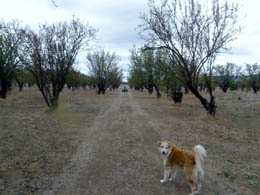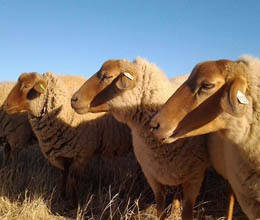Perspectives on Drought Part 1: Alexis Robertson of Skyelark Ranch
- By Alexis Robertson
- Reading Time: 5 mins.

Recently, California’s growers and water districts approached Governor Jerry Brown to declare California in a state of drought. It has been one of the driest winters on record and the state’s reservoirs, snow pack, streams and rivers have been greatly depleted. Here in the valley we are holding our breath anxiously anticipating the start of the rainy season. We hope that it will come quickly and quench the sunbaked hills.
A drought creates challenges for everyone but, quite understandably, it can be a great challenge to our farmers and ranchers. Many of them have big concerns about the drought conditions this year. This week, one of our valley ranchers Alexis Robertson, who ranches with her husband Gillies at their ranch Skyelark, explains why a drought is such a challenge for ranchers that raise their animals on pasture. Alexis and Gillies raise chickens, sheep, swine and turkey.
SW: Is drought a big concern for ranchers this year?
AR: Definitely, it is all we have been talking about lately. Ranchers rely on grass growth to feed their livestock throughout the year. In a normal year the Fall rain will germinate grasses which provide some feed in the winter. During the cold wet winter months that grass generally goes dormant and then has a head start once the days lengthen and get warmer in early spring. What is left is used as standing feed when needed through the summer until new growth starts again in Fall. Currently, in the Capay Valley, we haven’t had any Fall germination yet and the soil is as dry as it was in summer meaning the grass isn’t close to growing. Ideally, our rain would come in steady amounts through the ”˜wet’ season providing the soil with moisture, and replenishing our groundwater supplies. This year, if the rain comes at all, we will probably be faced with large amounts all at once (this is some speculative ranching) increasing surface runoff and soil erosion, lowering the availability of water for plant growth and subsequent animal feed.
SW: How are your day-to-day activities affected by drought, or are they not affected at all?
AR: Right now we are now spending a lot more time feeding hay, far more than we would be in a normal rain year. Normally we would only be supplementing our animals grazing feed with hay rather than providing 100% of their diet.
SW: How does drought impact the animals, specifically their diet?

AR: As mentioned before, through the winter, most folks are feeding some alfalfa or other hay to supplement the available dry and new grass. If we get no rain at all this year, obviously that hay feeding will continue until fall at the earliest. If we get some rain, it will take a while for that to germinate and grow forage suitable for animal feed. It may also be hard for some nutritious grass species to outcompete the more invasive and less palatable species such as medusahead and yellow starthistle, which grow later than the early germinating annual grass and flowering plants species, known by the technical term forb, like vetch, oats, ryegrass, and brome. Although our poultry and swine do not rely on grass or forage as much as sheep and cattle do, we still count on them for the nutrients they provide and, ultimately the quality and flavor profile of our final product.
SW: Are their any health concerns associated with drought and animals?
AR: The lack of protein and good available forage can make it more challenging to maintain what we refer to as an animals “condition.” We will begin to see more animals in poor condition as the drought continues and as the cost of hay inhibits a ranchers’ ability to maintain their animals in good condition. That’s when you start to see animals become less able to defend against infection and disease, much as you would with humans. A lot of ranchers begin to implement drought plans to avoid this from happening. A drought plan can involve selling off or culling low-producing or older animals earlier than would normally occur, finding new pasture, or weaning calves or lambs earlier to reduce the stress on the milking mothers.
SW: Is the cost higher for producing meat during a drought?

AR: Yes because hay costs MUCH more than allowing the animals to graze and find their own feed in a managed pasture. In a drought year that expensive and time-consuming supplement suddenly becomes the only source of feed. Ranchers will often also have smaller herds and so need to adjust their prices to compensate for the reduced income. Also, in areas where irrigated pasture is available, the price of the water for irrigation will go up due to lack of recharge and low water availability throughout the state. In the Capay Valley, we are already seeing the effects of this, as much of our water supply is from the Indian Valley and Clear Lake reservoirs. One of these is already empty. This means smaller allocation of water for our Water District and a higher cost for what little water there is.
SW: What is the biggest expense for caring for animals during a drought?
AR: Hay and increased labor.
SW: How does that impact meat prices?
AR: In addition to the higher cost of feeding the animals, a rancher’s time is also undervalued when he/she has to spend more time feeding livestock. That adds to the cost of production but is often overlooked as an added impact.
SW: Is there a silver lining in all of this?
AR: Not really, the only benefit is that it forces us to make culling decisions that we wouldn’t otherwise make to maintain a healthy and productive flock. We are going to be tightening up our belts, and our genetics here on our ranch. It also forces you to be a better manager of what little resources we have.
By Farm Shop Employee Alexis Robertson, co-authored and edited by Seth Wright,


